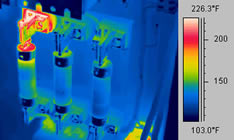Thermography Extends MTBF From 2 Years 3 Months To 5 years
Long before equipment fails it will experience a significant rise in temperature. Although you cannot physically see this rise in temperature, you can use certain tools to recognise it. The application of thermography detects temperatures via infrared radiation and converts it into visible light, which allows for a condition monitoring engineer to detect static electrical equipment such as fuse boards, distribution and control panels that are overheating before it turns into a fault or failure.
By using thermal inspection equipment it removes the need for unreliable guess work from proactive engineering and enables the real preventative maintenance to begin. It identifies what equipment needs attention before visible issues arise, and can warn the engineer as to what equipment is just starting to deteriorate and will need future repairs. Performing this type of preventative maintenance technology can help reduce more expensive repairs, which in turn prevents health and safety issues and unplanned downtime while increasing reliability and productivity.

The use of thermography as part of a scheduled maintenance programme enables early recognition of equipment faults which makes for a more comprehensive preventative or predictive maintenance programme. If thermography equipment is utilised as part of an automated predictive maintenance programme it can also be used to trigger alarms when equipment reaches a certain temperature. If regular maintenance is performed, the temperatures can be recorded and trended, this can identify what is the normal temperature for your equipment
Other applications include rotating machines such as electric motors, pumps, gearboxes etc., however the process is quite different. Unlike static equipment, temperature in rotating machines is a result of a developing fault condition which could have deteriorated to failure by the time a periodic thermography survey has detected changes in operating temperature. In these applications a thermal imager capturing temperatures from thousands of points all at once from critical components, which is unlike infrared thermometers which can only capture temperatures at a single point. For example, you could read the temperature of the motor, shaft bearings, gearbox and shaft coupling all at once. Each motor can operate at a specific internal temperature which can be read via the temperature of the exterior surface. Other components of the motor should not reach as high a temperature as the motor housing. An experienced engineer will be able to assess the readings that a thermal imaging identifies and identify conditions; including potential bearing failure, inadequate airflow and degrading of insulation in the rotor or stator in the motor.
Other applications for infrared technology include military and civilian purposes, including:
- Target Acquisitions
- Surveillance
- Night Vision
- Environmental monitoring
- Industrial Facility Inspections
- Weather Forecasting
For more information about the use of Thermography in our Condition Based Monitoring Programmes contact CPM on 0161 865 6161 or email info@cpm-uk.com.
